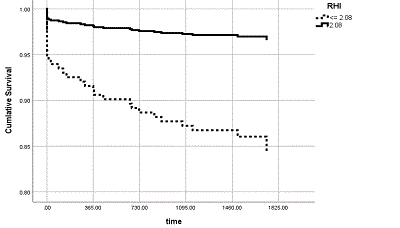
Endothelial Function Predicts 5-year Adverse Clinical Outcome in Patients Hospitalized in the Emergency Department Chest Pain Unit
2Mayo Clinic, Division of Cardiovascular Diseases
3Tel Aviv University, The Sackler Faculty of Medicine
Background: Endothelial function is a marker for cardiovascular risk. Thus, abnormal endothelial function may be associated with adverse 5-year outcome in patients presenting to the emergency department chest pain unit (CPU).
Methods: Following endothelial function testing, using EndoPAT 2000 in 300 consecutive subjects with chest pain and no history of coronary artery disease (CAD) presenting to CPU, patients underwent coronary computerized tomographic angiography (CCTA) or single-photon emission computed tomography according to availability.
Results: Mean 10-year Framingham risk score (FRS) was 6.6±5.9%, mean 10-year Atherosclerosis Cardiovascular Disease (ASCVD) Risk 7.1±7.2%, median reactive hyperemia index (RHI) as a measure of endothelial function 2.0 and mean was 2.0±0.4. During a 5-year follow-up, the 30 (10%) patients who developed major adverse cardiovascular end-points (MACE), including all-cause mortality, non-fatal myocardial infarction, hospitalization for heart failure or angina pectoris, stroke, coronary artery bypass grafting and percutaneous coronary interventions, had higher 10-year FRS (9.6±7.8% vs 6.3±5.6%; p=0.032) as well as higher 10-year ASCVD Risk (10.4±9.2% vs 6.7±6.9%; p=0.042), lower baseline RHI (1.6±0.5 vs 2.1±0.4; p<0.001) and a greater extent of coronary atherosclerosis lesions (53% vs 3%, p<0.001) in the CPU CCTA, compared to those without MACE. Multivariate analysis demonstrated that RHI ≤ the median is an independent predictor of 5-year MACE (OR 4.903, 95% CI 1.85-12.97; p<0.001).
Conclusions: Our findings suggest that non-invasive endothelial function testing may have clinical utility in triaging patients in the CPU and in predicting 5-year MACE.



Powered by Eventact EMS